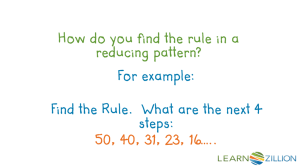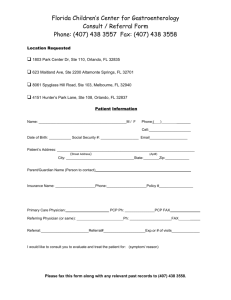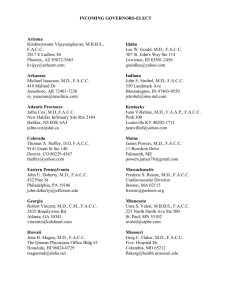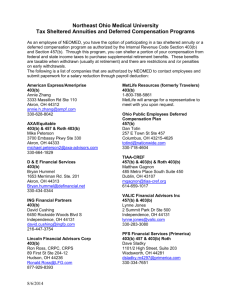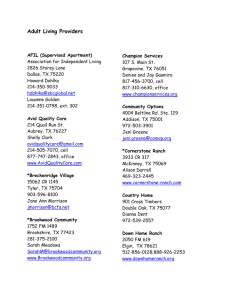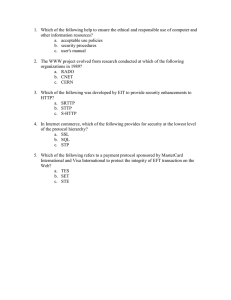AppendixII
advertisement
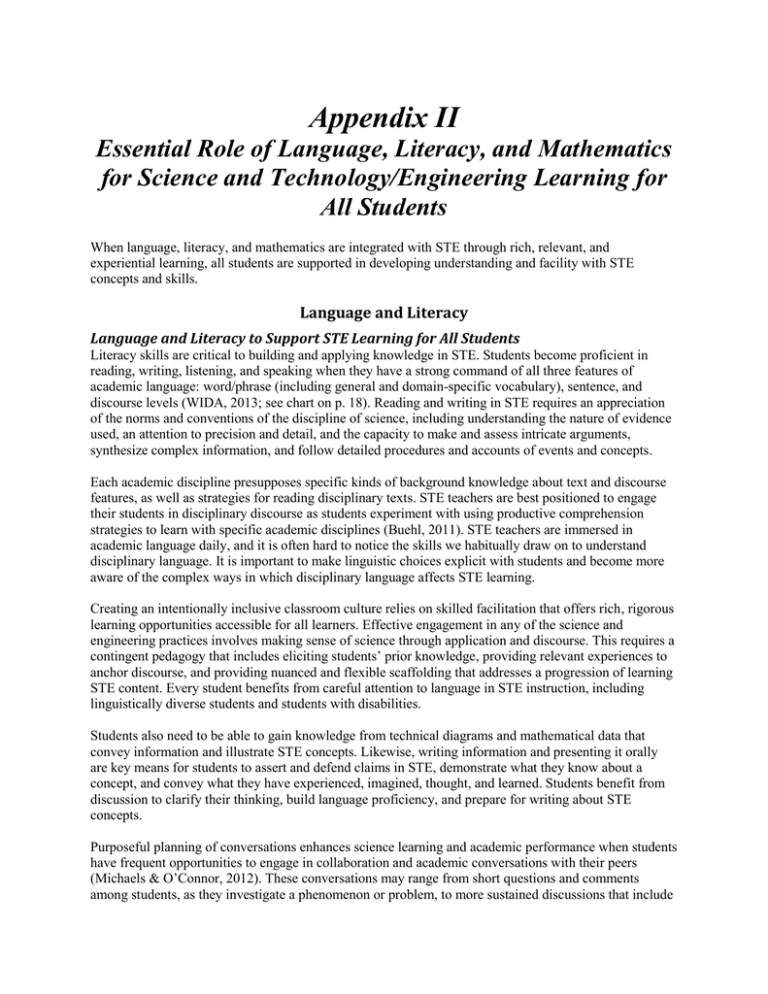
Appendix II Essential Role of Language, Literacy, and Mathematics for Science and Technology/Engineering Learning for All Students When language, literacy, and mathematics are integrated with STE through rich, relevant, and experiential learning, all students are supported in developing understanding and facility with STE concepts and skills. Language and Literacy Language and Literacy to Support STE Learning for All Students Literacy skills are critical to building and applying knowledge in STE. Students become proficient in reading, writing, listening, and speaking when they have a strong command of all three features of academic language: word/phrase (including general and domain-specific vocabulary), sentence, and discourse levels (WIDA, 2013; see chart on p. 18). Reading and writing in STE requires an appreciation of the norms and conventions of the discipline of science, including understanding the nature of evidence used, an attention to precision and detail, and the capacity to make and assess intricate arguments, synthesize complex information, and follow detailed procedures and accounts of events and concepts. Each academic discipline presupposes specific kinds of background knowledge about text and discourse features, as well as strategies for reading disciplinary texts. STE teachers are best positioned to engage their students in disciplinary discourse as students experiment with using productive comprehension strategies to learn with specific academic disciplines (Buehl, 2011). STE teachers are immersed in academic language daily, and it is often hard to notice the skills we habitually draw on to understand disciplinary language. It is important to make linguistic choices explicit with students and become more aware of the complex ways in which disciplinary language affects STE learning. Creating an intentionally inclusive classroom culture relies on skilled facilitation that offers rich, rigorous learning opportunities accessible for all learners. Effective engagement in any of the science and engineering practices involves making sense of science through application and discourse. This requires a contingent pedagogy that includes eliciting students’ prior knowledge, providing relevant experiences to anchor discourse, and providing nuanced and flexible scaffolding that addresses a progression of learning STE content. Every student benefits from careful attention to language in STE instruction, including linguistically diverse students and students with disabilities. Students also need to be able to gain knowledge from technical diagrams and mathematical data that convey information and illustrate STE concepts. Likewise, writing information and presenting it orally are key means for students to assert and defend claims in STE, demonstrate what they know about a concept, and convey what they have experienced, imagined, thought, and learned. Students benefit from discussion to clarify their thinking, build language proficiency, and prepare for writing about STE concepts. Purposeful planning of conversations enhances science learning and academic performance when students have frequent opportunities to engage in collaboration and academic conversations with their peers (Michaels & O’Connor, 2012). These conversations may range from short questions and comments among students, as they investigate a phenomenon or problem, to more sustained discussions that include presenting evidence to support a claim, critiquing a solution, or evaluating a problem. They listen and process information as they present their ideas or engage in reasoned argumentation with others to refine their ideas, critique others, and reach shared conclusions. Students must also read, write, and visually represent ideas as they develop models and construct explanations. The requirements and norms for classroom discourse are shared across all the STE disciplines and, indeed, across all the subject areas. All students stand to gain from effective STE instruction that involves experience with science and engineering practices. Teachers must carefully plan to scaffold, modify, facilitate, and support all students to access STE content and practices as well as language development. When supported appropriately, all students can learn, comprehend, and carry out sophisticated language functions1 in STE contexts (e.g., arguing from evidence, providing explanations, developing models). For English language learners in particular, the focus is on the developmental nature of language and the careful use of instructional supports and scaffoldings so all students can participate in grade-level curricula and higher-order thinking. For students with disabilities, knowing what they need to be successful and providing differentiated ways for them to develop and communicate their understanding is essential. Role of Vocabulary in STE Instruction Students need to have a facility for using technical terms in order to effectively learn complex STE to communicate with others about their learning. In STE, vocabulary provides the labels used to represent a concept or process. A vocabulary-rich classroom encourages students to link their conceptual understanding with key scientific and technical terms. This promotes clearer and more efficient communication about the content and enables shared understanding. Science and engineering build knowledge over time through collaborative exchanges and peer review of new knowledge and processes. As a student’s body of knowledge grows, their scientific and technical vocabulary should grow with it. Without strong literacy skills, including the understanding and use of scientific and technical vocabulary, students will have difficulty participating in STE endeavors or understanding scientific and technical texts, even texts that are written for a general audience. The STE standards represent specific choices about which vocabulary to include and which to omit in defining learning outcomes. Where possible, a focus on the underlying scientific concept or process has been emphasized and lists of scientific and technical terms have been minimized. In a few instances, a state assessment boundary clarifies that certain terms will be excluded from state assessments. The omission of such terms from the standards or the state assessment, however, does not imply that students should not learn them. Educators should make deliberate choices about which scientific and technical vocabulary to have students learn and use in their studies and classroom discussions that can go beyond vocabulary used in the standards. It is important to recognize that effective communication about STE includes more than vocabulary. Language is an integral part of learning STE: not only a tool for communication, but also a tool for scientific thinking and reasoning. Students learn to engage in scientific thinking and reasoning by making conjectures, presenting explanations, and constructing arguments, all of which require a shared vocabulary to achieve more. Mathematics Mathematics is a language and a key tool used in STE. STE also provides an excellent context for learning and applying mathematics. Students use mathematics in STE to represent physical variables, describe relationships among variables, and make quantitative predictions. Computers and digital tools 1 “Language function” refers to the purpose for a particular use of language (e.g., recount, explain, argue). It is what students do with language to accomplish content-specific tasks. can enhance the power of mathematics by automating calculations, approximating solutions to problems that cannot be calculated precisely, and analyzing large data sets to identify meaningful patterns. Students use laboratory tools connected to computers for observing, measuring, recording, and processing data. Students also engage in computational thinking, which involves strategies for organizing and searching data, creating sequences of steps (algorithms), and using and developing new simulations of natural and designed systems. Modeling is a particular area where STE and mathematics have significant overlap. Students develop and use models in their STE classes to describe the complex systems in our natural world, and then augment these models using mathematics. The descriptions, predictions, and analyses that such mathematical models yield can be rich and dynamic and can include tables, graphs, equations, algorithms, words, and computer simulations. Mathematics is a key tool for describing, predicting, and analyzing the world. Summary Students experience and navigate the world as an integrated whole. Language, literacy, mathematics, science, technology, and engineering are seamlessly interwoven in our everyday lives. The purposeful attention to relationships across content areas strengthens STE learning for all students. The Venn diagram below shows some ways in which these relationships overlap in state standards: Relationships of disciplinary practices across the Massachusetts Curriculum Frameworks for English Language Arts and Literacy, Mathematics, and Science and Technology/Engineering (based on work by Tina Cheuk; ell.stanford.edu). The disciplinary practices overlap and connect in multiple ways; with effective instruction, they can make learning relevant and meaningful for all students. Attention to the discipline-specific ways in which language is used within and across each of these areas is essential, as language is the medium through which learning occurs and knowledge is exchanged in all classrooms. [This appendix draws from NGSS, Appendix D.] References Buehl, D. (2011). Developing Readers in the Academic Disciplines. Newark, DE: International Reading Association. Lee, O., Quinn, H., & Valdés, G. (2012). Language demands and opportunities in relation to Next Generation Science Standards for English Language Learners: What teachers need to know. Understanding language. Stanford University. Retrieved from ell.stanford.edu/papers Michaels, S., & O’Connor, C., (2012) Talk science primer. TERC. Retrieved from inquiryproject.terc.edu/shared/pd/TalkScience_Primer.pdf WIDA. (2013). Essential actions: A handbook for implementing WIDA’s framework for English language development standards. Board of Regents of the University of Wisconsin System. Retrieved from www.wida.us/get.aspx?id=712
